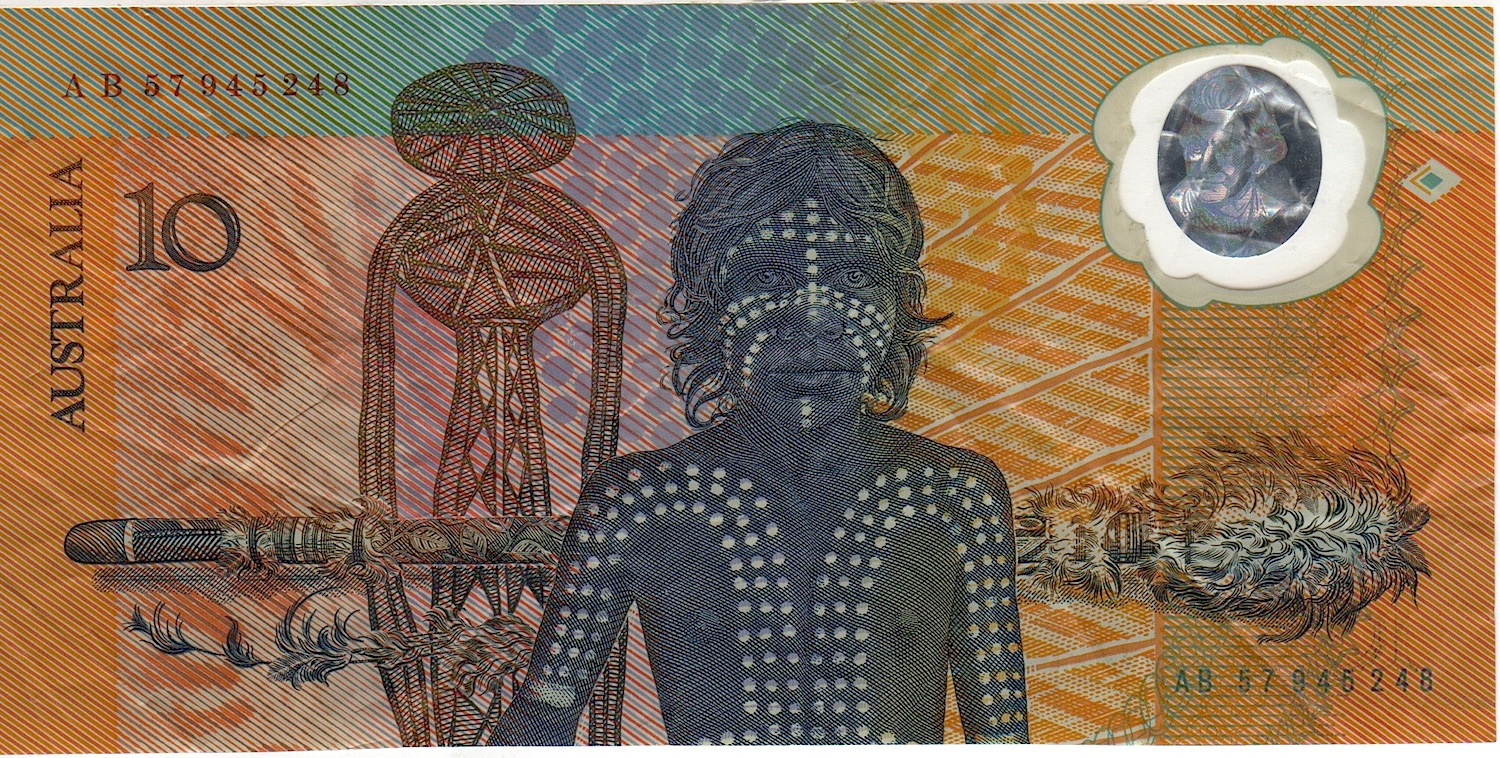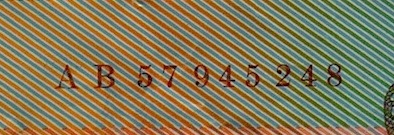An AB57 94 $10 Bicentennial Note - An Oddity or An Important Exception?

The recent discovery of a 1988 Bicentennial $10 note with an AB 57 serial prefix, and a serial number beginning with the digits “94”, has brought fresh scrutiny of the characteristics that have long been used to differentiate between the two production runs of Australia’s circulating bicentennial $10 polymer banknotes.

It is not yet clear whether the newly-identified note is simply a serial numbering oddity, or an important exception to the long-held rule used by numismatists to classify Australia’s first commemorative banknote.
For those collectors not immediately familiar with Australia’s Bicentennial $10 note, they were printed and released in two separate stages - the first was “for a few days [1]” in late January 1988, the second ran from October 1988.
The First Production Run - R310a
The very first 1988 Bicentennial notes were issued into circulation on Wednesday January 27th 1988 (January 26th was a public holiday and all banks were obviously closed).
As can be expected, the new notes were keenly received by the general public, so much so that there were immediate reports of the holograms being badly damaged when scratched with a coin. Not only was the quality of the notes not as high as the government had hoped, but industrial action, specifically “…a manning dispute involving a coating machine…[2]” at Note Printing Australia (NPA)brought production of the notes to a halt.
As a result of the quality control issues and the industrial action, “issue of the notes were suspended ”after a few days"[3].
The Second Production Run - R310b
The Bicentennial $10 note was only released into circulation again after the printing process had been completely overhauled, on October 24th, 1988 [4].
The Difference Between The Two
The first official indication of any difference between the two different production runs of notes was published in the NPA Newsletter, on May 16th 1989: "“All the notes issued early in the year were … in the AB10 through AB33 series. There were also notes in the AB34 to AB57 range [^fn-5_footnote] [released from October onwards].”
By 1990, the banknote collector Harold Peake had completed what was described as “an exhaustive study of the 1988 Bicentennial $10 note [5]”. Peake identified that meaningful technical characteristics could differentiate between notes from the two different production runs.
An article written by Peake and published in the Australian Coin Review in May 1991 explained that “…without doubt, the initial release of the ten dollar plastic notes at the end of January 1988 all had serial numbers which fall into a definite range. As a result, these notes can be identified by any collector in seconds by simply reading the serial number. [^fn-7_footnote]”
Peake further went on to say in that article that “The first issue notes all had prefixes from AB10 to AB33 inclusive and serial numbers starting with 93, 94 or 96.”
The second edition of Greg McDonald’s hardback book “Collecting and Investing in Australian Coins & Banknotes” stated that the first circulation series of 1988 $10 notes had prefixes “AB10 to AB33 with several numbers commencing 93, 94 or 96.” A footnote on the same page also stated that these notes had a “Six digit serial number commencing 93, 94 or 96.” The second circulation series of 1988 $10 notes was described as “Prefixes AB10 to AB57, omitting serial number used for first printing.”
The first Rennik’s “Australian Coin & Banknote Values” book to list these notes describes the first series notes with “Prefixes AB10-AB33, Third & foiurth numerals with 93, 94 or 96.”
Chinese Whispers / Lost In Translation
Peake’s assertion that “these notes can be identified by any collector in seconds by simply reading the serial number [6]” perhaps is not as definitive as we’d all like to think.
The reason I believe this is that in Peake’s article in May 1991, he stated that “None of the second release notes with these prefixes [AB10 through to AB33] had numbers staring with 9, although the later prefix series of the AB notes with prefixes AB 34 to AB 57 did use serial numbers starting with a 9.[7]”
Further to that, in the second edition of Greg McDonald’s hardback book “Collecting and Investing in Australian Coins & Banknotes”, Peake further states that “None of the later notes [i.e. second series] had a serial number commencing with a nine except the later prefix series of the AB notes which had prefixes running through from AB 34 to AB 57. These were the last of the AB series and have nothing to do with the original notes.[8]”
The descriptions of the differing types of 1988 $10 notes as they first appeared in Australia’s pricing guides are accurate, however they are only accurate when read in their entirety - only IF a note has a serial prefix between AB 10 and AB 33 AND has a serial number in which the 3rd and 4th digits are 93, 94 or 96, THEN is it from the 1st print run.
Unfortunately, the collecting community seems to have forgotten the rather important qualifier that both of these two criteria need to be in place for the attribution to be correct. The current Renniks catalogue simply states that “The first printing is identified by serial numbers containing 93, 94 or 96 as the 3rd and 4th numerals.”
Notice that no mention is made of the fact that the note must also have a serial prefix ranging between AB 10 and AB 33.
The current McDonald guide includes two comments, the first being “Prefixes with 3rd & 4th numerals in serial being 93, 94 or 96 only”, the second is a little more detailed “Prefix range from AB 10 to AB 33. Six digit serial number must commence with first two digits reading 93, 94 or 96.”
Concordantly, this criteria also means that IF a note has a serial prefix between AB 34 and AB 57 AND has a serial number in which the 3rd and 4th digits are 93, 94 or 96, THEN it is from the second print run.
I may well be in the vocal minority, but as a dealer that’s been active full-time for a bit over a decade now, I have only ever knowingly handled one second series note that has serials has a serial number in which the 3rd and 4th digits are 93, 94 or 96, and I have only ever heard of one other similar note in addition to that.
So apparently rare are these apparent oddities that when first sighted, they confound the eye such that the immediate explanation for their existence is that they are a printing error - they’re either a first series note mistakenly printed with a serial number only intended for the second series, or they’re a second series note with a serial prefix only intended for the first series.
The total mintage of the second series is widely acknowledged as being 19 million notes, yet this is just a third of the maximum number of notes that could have been printed in the second series - 57 million notes.
Given that ratio, I can’t help but think that notes from the second half of the second series WITH a serial prefix between AB 34 and AB 57 AND with a serial number in which the 3rd and 4th digits of 93, 94 or 96 are quite a bit rarer than most collectors might think.
I believe that the first order of the day is for the price guides to ever so slightly clarify the identifying information they print regarding the 1st series notes, as this will then allow collectors to correctly classify the notes they have in their collection.
At this stage, it is my belief that the only second series 1988 $10 notes that have a serial number in which the 3rd and 4th digits are 93, 94 or 96, also have the rare AB 57 (last) prefix. If that is the case, then the total mintage of such notes would be a maximum of just 30,000 notes - a tiny fraction of the total mintage of 19,000,000. It will be very interesting indeed to see how many more notes with this serial prefix and number permutation come to light once clarified identifying information has been widely published.
Are they simply a serial numbering oddity, or are they an important exception to the long-held rule used by numismatists to classify Australia’s first commemorative banknote?
-
Peake, p105 ↩
-
McDonald, Greg; “Investing in Australian Coins & Banknotes”; 2nd edition; self-published; page 194 ↩
-
Peake, Harold; “Australian Accidental Banknotes”; Buderim; 1994; Self-published; p105 ↩
-
NPA Newsletter #5 - 16.5.1989 ↩
-
McDonald, Greg; “Investing in Australian Coins & Banknotes”; 2nd edition; self-published; page 194 ↩
-
Peake, Harold; “Australian Coin Review Magazine”; May 1991; page 32 ↩
-
Peake, Harold; “Australian Coin Review Magazine”; May 1991; page 32 ↩
-
McDonald, Greg; “Investing in Australian Coins & Banknotes”; 2nd edition; self-published; page 194 ↩